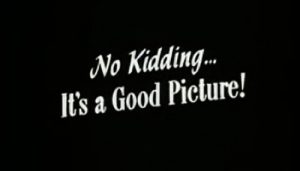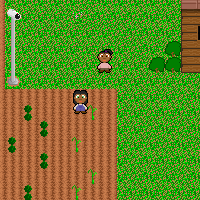Lower Your Expectations
It’s in your movie trailers, your commercials, your “Next time on…” and “In tonight’s very special episode of…” reels. It’s on billboards, buses, cereal boxes, book signings. It’s in your mouth and in your brain, and it exists from the very first moment a project is pitched. There’s no killing it. Every mass-market entertainment or work of art has to be sold ten times over the course of its lifespan, first to the producers/publishers/curators, then to the creative team, the advertising partners, and finally to you. Hype doesn’t just make you want to buy a game, book, album or movie ticket. Without hype, you wouldn’t even know the game/book/band existed. And somewhere further back along the road, without hype, they wouldn’t.
There’s just one problem: hype ruins everything it touches. There’s a reason they’re called spoilers, after all, and the hype engine runs on them. These aren’t the quaint ’40s, when movie studios could get away with releasing a trailer that showed absolutely no details of the film (and remains, therefore, one of the most effective trailers of all time). These days, you can’t expect to sit through a 3.5 minute movie trailer without having the first, second, and most of the third act spoiled for you. It’s enough to make you wonder why screenwriters ever bother writing a first act to begin with, since everybody in the theater already knows the setup: they know the villain, they know the love interest, they know the one-liners, and the sure as heck know that the guy beneath the hat will turn out to be Harrison Ford.
It’s a terrible catch-22, because those same spoilers that kill any suspense or rising tension the screenwriter has sculpted into the film’s first half hour are also, most of the time, the only thing differentiating the film itself from a dozen others the audience could have paid to see. Movies are expensive, and studios want to ensure that people pay to see them; to do that, they can’t afford not to cram as many highlights as they can into the trailer, no matter how it mangles the film’s narrative structure. This is a problem in movies, but it’s also more or less a problem in any creative industry that can be packaged and sold, and hype has hit the video game industry hardest of all. Video game releases are events in a way that only movies based on a J.R.R. Tolkien property tend to be, to the point that the release can sometimes overshadow the game itself.
Perhaps you’ve experienced it yourself–most serious gamers have. On a glorious Tuesday afternoon, you find yourself in possession of the latest AAA masterpiece. As it downloads and installs the launch-day software updates, you flip through the manual, salivating over the weapons, characters and locations you’re soon to experience firsthand, all familiar from the copious amounts of pre-release screenshots and trailers. You’ve seen them all, followed every minute drop and rumor concerning the game’s progress. You’ve watched the video reviews, downloaded the demo, bought the DLC season pass. You’ve got the strategy guide beside you. You’re prepared. The game finally boots up, and for a few minutes, you’re in a gamer’s paradise.
For some people, this euphoria lasts all the way through the game. They’re the lucky ones. For everybody else, an unpleasant suspicion slowly sinks in. Skipping impatiently past the tutorial messages explaining features you were expert in months before the demo was released, you fight an urge to fast forward through the mammoth setpieces and dramatic cutscenes as well. You can’t wait to get to the new content, the stuff you haven’t seen before, but it never arrives. After months, sometimes years spent following the hype train, what could the game itself possibly have left to offer?
Games live and die on hype alone. At an average $60 MSRP, they’re even more of a luxury item than a movie ticket. It’s the rare consumer who just snags a random game off of the shelf, and it takes some serious selling to move those $60 discs. And they’re an even bigger financial risk for the publisher, who can’t afford not to pimp out that mind-boggling boss battle they pumped millions of dollars into. Generally, hype works, at least as far as getting the games sold. BioShock Infinite, which was borne aloft by a steam-powered hype engine ranging from developer diaries, a 10″ statue and a Flash game only available to pre-order patrons, and a tabletop implementation, was the most preordered game in America as of the week of its release. Hype gets games sold, but few people would assert it makes the game better. Oftentimes, a more unique and memorable gaming experience can be had by going on an anti-hype campaign, strategically lowering the player’s expectations.
As hard as good publicity can be to maintain, an anti-hype campaign is even harder, which is probably why we see it so seldom. There is a sea of hype keeping the industry afloat, and every publisher has to choose whether to swim or drown. There was, however, one game that tried the gambit and scored big time: Portal, Valve’s Half-Life spin-off that instantly spawned a thousand memes on the day of its release.
There was certainly hype surrounding the game prior to its release, but it was a nerdy kind of hype centered mostly around the game’s mechanics. Bundled in Valve’s Orange Box disc along with big releases like Half-Life Episode 2 and Team Fortress 2, Portal could afford to play it cool, looking like nothing more than a clever proof of concept, a 2-hour tech demo for a possible gameplay evolution of the Half-Life franchise. Nobody expected it to actually have a story. And even when players got used to the sharp writing behind the game’s robotic antagonist, it still appeared to be nothing more than a traditionally structured puzzle game, until the final act when the curtain was peeled back. The game’s deliberately minimal aesthetics and traditionally paced puzzle structure provided sharp contrast to its exhilarating finale, pushing the phrase “The cake is a lie” to the top of the meme charts.
Portal 2, although it retained the snarky wit and mind-warping puzzle design of the original, could never achieve the same effect. For one thing, it was now a Big Thing worthy of a hype engine all its own, all the digital real estate a single disc could afford, and a larger price tag to go along with its new celebrity status. It also pushed the first game’s well-hidden adventure aspect to the fore from the beginning. Although it delivered, in all important ways, more of everything Portal had to offer, that “more” was just not enough, because by that point, it was what people expected.
Where the anti-hype gambit really thrives is in the world of free online Flash games. There are still some difficulties, but it takes very little to convince somebody to try a game, no matter how dull or derivative it looks, when there is no attached investment of time or money. Furthermore, the bar is simply lower on sites like Newgrounds and Kongregate; while there are some excellent indie games out there, they’re often buried under steaming mounds of digital garbage.
But it’s a good thing these landfills of student projects gone wrong and other games-that-shouldn’t-be exist, because they’re the perfect fertilizer for games like The Day, a tiny, frankly ugly game about a trading card contest that strays far from the beaten path. Sometimes the games open up in small ways, like Drop a Beat, Giuseppe! and its multiple well-hidden endings, and sometimes the surprises are massive, like Frog Fractions or downloadable game Gravity Bone. The “aha!” moment can be sudden and obvious, or the realization might dawn on you slowly, as it does in Tom Davies’ FPS-MAN. Occasionally, they surprise you by being less of a game than you expect, as seen in You Have To Burn The Rope and Super PSTW Action RPG. No matter how they do it, there’s a treasure trove of indie creations out there that will have you scratching your head one minute, wondering what the fuss is about, and picking up your jaw off the floor the next.
Of course, simply by telling you that there’s more to these games than meets the eye, I’ve already raised your expectations far beyond where they should be. But the point isn’t simply that you ought to be playing these games. The point is that these games, with budgets and assets that are downright microscopic compared with even the most low-budget mass-market game release, manage to create such a distinct impression simply by building on no impression, at least to start. Enjoyment isn’t always measured in numbers and statistics. It’s measured in peaks and valleys, and games that only offer a plateau, no matter how high it is, will never be as memorable as games that start low and climb. Perfection isn’t all it’s cracked up to be.






